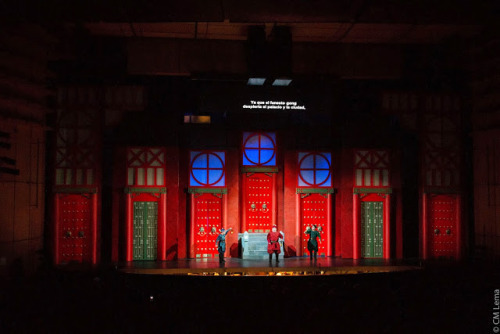#giacomo puccini
Para empezar con un trabajo presentado en Colombia recientemente, les muestro algunas fotos y renders del diseño escenográfico de “Turandot”.


Turandot (una ópera de tres actos estrenada en Milán en 1926) escrita por Giacomo Puccini y finalizada por Franco Alfano cuenta la historia de Turandot, una princesa China que solo se casará con el hombre que pueda resolver tees complicados acertijos. Quien falla es condenado a la muerte.
La historia cambia cuando llega Calaf, un príncipe exiliado quién logrará resolver los acertijos. A lo largo de la historia se irán revelando amores secretos para descubir al final el nombre del amor.


El diseñador de escenografìaEdwin Erminy utilizó como referencia arquitectónica la Ciudad Prohibida de Beijing. “La maquinaria dura de la Ciudad Imperial, los niveles de la sociedad rígidamente estratificada y la frialdad de Turandot están implícitos en el diseño”


*Además de ser una ópera que se presentó recientemente en Colombia fue la primer ópera a la que fui en vivo por lo que es especial*
*Fotografías tomadas de la página del escenógrafo Edwin Erminy*


currently hearing: la boheme
A scene from Puccini’s opera Gianni Schicchi. The Donati relatives listen to the reading of the will.
Gianni Schicchi is a comic opera in one act by Giacomo Puccini to an Italian libretto by Giovacchino Forzano, composed in 1917–18. The libretto is based on an incident mentioned in Dante’s Divine Comedy. The work is the third and final part of Puccini’s Il trittico(The Triptych) – three one-act operas with contrasting themes, originally written to be presented together. Although it continues to be performed with one or both of the other trittico operas, Gianni Schicchi is now more frequently staged either alone or with short operas by other composers. The aria “O mio babbino caro” is one of Puccini’s best known, and one of the most popular arias in opera.
Puccini had long considered writing a set of one-act operas which would be performed together in a single evening, but faced with a lack of suitable subjects and opposition from his publisher, he repeatedly put the project aside. However, by 1916 Puccini had completed the one-act tragedy Il tabarro and, after considering various ideas, he began work the following year on the solemn, religious, all-female opera Suor Angelica.Gianni Schicchi, a comedy, completes the triptych with a further contrast of mood. The score combines elements of Puccini’s modern style of harmonic dissonance with lyrical passages reminiscent of Rossini, and it has been praised for its inventiveness and imagination.
When Il trittico premiered at New York’s Metropolitan Opera in December 1918, Gianni Schicchi became an immediate hit, while the other two operas were received with less enthusiasm. This pattern was broadly repeated at the Rome and London premieres and led to commercial pressures to abandon the less successful elements. Although on artistic grounds Puccini opposed performing the three operas except as the original triptych, by 1920 he had given his reluctant consent to separate performances. Gianni Schicchi has subsequently become the most-performed part of Il trittico and has been widely recorded.
Post link

Poster of Puccini’s “Madama Butterfly” by Adolf Hohenstein (1854-1928), 1904
//My photo//


